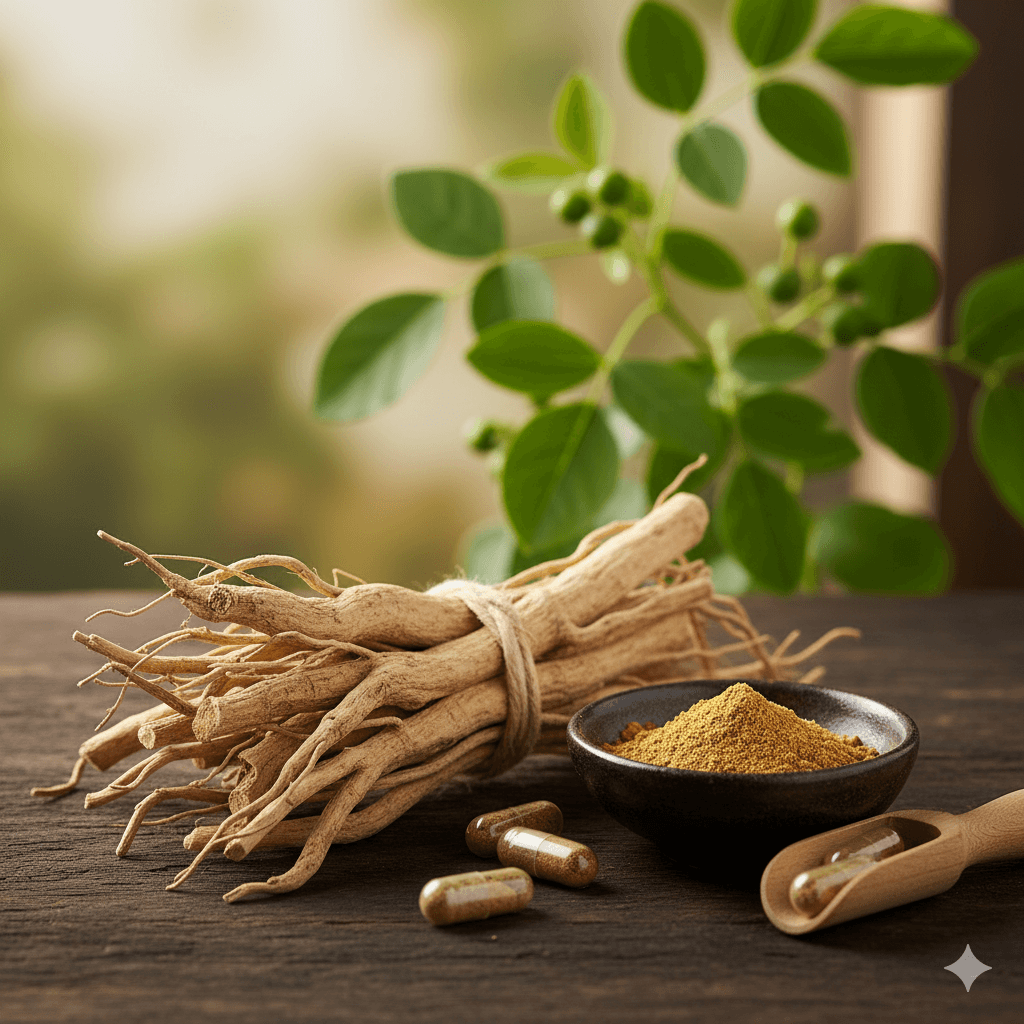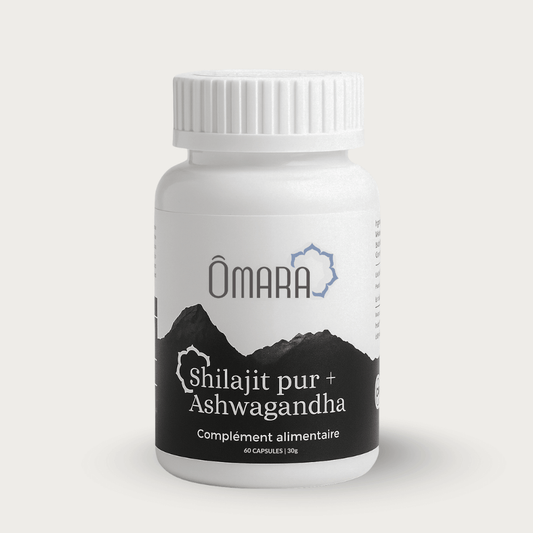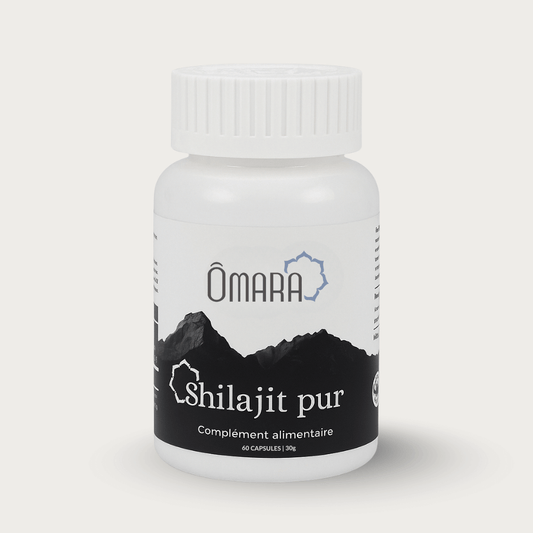
Ashwagandha: The Ancient Adaptogen for Balance and Vitality, and its Synergy with Shilajit
Share
Last updated: October 13, 2025
Ashwagandha (Withania somnifera) holds a special place in the pantheon of medicinal plants, revered for millennia in Ayurvedic medicine for its exceptional adaptogenic properties. Nicknamed "Indian ginseng," this powerful herb is known for its ability to help the body manage stress, restore balance, and promote lasting vitality [1, 2]. Beyond its traditional uses, modern science is increasingly interested in its many benefits, ranging from improving cognitive function to optimizing physical performance.
However, the effectiveness of an adaptogen lies not only in its active compounds, but also in how the body assimilates and uses them. This is where synergy with other natural substances comes into its own. In this article, we'll explore Ashwagandha in depth: its fascinating origins, key bioactive compounds, mechanisms of action as an adaptogen, and its many scientifically proven benefits. We'll also discuss, of particular interest, the potential synergy between Ashwagandha and Shilajit, an ancient mineral adaptogen known to enhance nutrient absorption and support mitochondrial function. Get ready to discover how to optimize your balance, performance, and well-being with this powerful duo.
1) What is Ashwagandha? Origins, Active Compounds and Mechanisms of Action
Ashwagandha, whose botanical name is Withania somnifera , is a shrubby plant belonging to the Solanaceae family. Its name, derived from Sanskrit, means "horse smell", referring to the characteristic odor of its root and its ability to impart the strength and vitality of a horse [3].
1.1) Origins and Traditional Use
Native to the arid regions of India, the Middle East, and parts of Africa, Ashwagandha is a cornerstone of Ayurveda, one of the world's oldest systems of holistic medicine. It is classified as a Rasayana , a type of Ayurvedic remedy that promotes physical and mental health, defends the body against disease and aging, and helps prolong life [4]. Traditionally, it has been used to:
- Reduce stress and anxiety: This is its most widespread use.
- Improve sleep: Hence its epithet somnifera (which brings sleep).
- Increase energy and stamina: Especially in people who are tired or convalescing.
- Support cognitive function: For memory and concentration.
- Strengthen immunity: As a general tonic [5].
1.2) Active Compounds: Withanolides
The main bioactive compounds responsible for the therapeutic effects of Ashwagandha are withanolides , steroidal lactones. Among them, withaferin A and withanolide A are the most studied [6]. These compounds act in various ways to modulate the body's biological functions. The quality and efficacy of Ashwagandha supplements are often evaluated based on their withanolide content [7].
1.3) Mechanisms of Action as an Adaptogen
Ashwagandha is classified as an adaptogen, meaning that it helps the body adapt to physical, chemical, or biological stress by normalizing physiological functions [8]. Its mechanisms of action are complex and multifactorial:
- HPA Axis Modulation: Ashwagandha works primarily by modulating the hypothalamic-pituitary-adrenal (HPA) axis, the body's central stress response system. It helps regulate the release of the stress hormone cortisol, reducing it during chronic stress and maintaining it at optimal levels [9, 10].
- Effects on Neurotransmitters: It can influence the activity of key neurotransmitters such as GABA (gamma-aminobutyric acid), which has calming and anxiolytic effects, and serotonin, which plays a role in mood and sleep [11, 12].
- Antioxidant Properties: Withanolides and other compounds in Ashwagandha possess powerful antioxidant properties, protecting the body's cells from damage caused by free radicals and oxidative stress [13].
- Anti-inflammatory Effects: It has demonstrated abilities to reduce inflammation by inhibiting inflammatory mediators, thus contributing to its general protective effects [14].
2) The Scientifically Proven Benefits of Ashwagandha
Ashwagandha is one of the most studied medicinal plants, and its benefits are supported by a growing scientific literature. Its adaptogenic properties translate into a multitude of positive effects on physical and mental health.
2.1) Reduction of Stress and Anxiety
This is the most recognized benefit of Ashwagandha. Numerous clinical studies have demonstrated its ability to significantly reduce levels of cortisol, the stress hormone, and improve symptoms related to stress and anxiety [9, 15]. Participants report an increased feeling of calm, better management of stressful situations and a reduction in mental fatigue [2].
2.2) Improved Sleep
Ashwagandha has traditionally been used to promote restful sleep, and modern research supports this property. Studies have shown that it can improve the quality and duration of sleep, helping people with insomnia fall asleep more easily and have a deeper sleep [16, 17]. Its anxiolytic effect also helps calm the mind before bed.
2.3) Support of Cognitive Function
The withanolides in Ashwagandha have neuroprotective effects and can improve various cognitive functions. Research indicates that it can improve memory, attention, concentration, and reaction time, especially in people under chronic stress or with mild cognitive decline [18, 19]. It also protects neurons from oxidative damage [12].
2.4) Increased Strength and Physical Performance
For athletes and active individuals, Ashwagandha can be a valuable ally. Studies have shown that it can increase muscle strength, improve cardiorespiratory endurance, and promote better recovery after exercise [20, 21]. It also helps reduce exercise-induced muscle damage and decrease fatigue [22].
2.5) Hormonal Balance and Reproductive Health
Ashwagandha plays a role in hormonal balance. In men, it can increase testosterone levels and improve sperm quality, thus contributing to fertility [23, 24]. It may also support thyroid function, particularly in people with subclinical hypothyroidism, by stimulating the production of thyroid hormones [25].
2.6) Antioxidant and Anti-inflammatory Properties
Due to its richness in withanolides and other bioactive compounds, Ashwagandha possesses potent antioxidant properties, protecting cells from free radical damage [13]. It also exerts anti-inflammatory effects by modulating inflammatory pathways, which may be beneficial for various inflammatory conditions [14].
3) How to Use Ashwagandha: Forms, Dosages and Precautions
Ashwagandha is available in various forms, and it is important to choose a quality product and follow the dosages correctly to get the most benefits while minimizing risks.
3.1) Forms and Extracts
Ashwagandha is mainly used in the form of root powder or standardized extracts. The quality of the extract is crucial for its effectiveness [26].
- Root Powder: The most traditional form, often used in Ayurvedic preparations. It contains all of the plant's compounds.
-
Standardized Extracts: These are concentrated forms where the content of withanolides (the active compounds) is guaranteed. The most well-known and clinically studied extracts are:
- KSM-66®: A full-spectrum root extract, standardized to 5% withanolides. It is widely used in research for its effects on stress, anxiety, performance, and testosterone [9, 20, 23].
- Sensoril®: A patented extract from the roots and leaves, standardized to 10% withanolides. It is often used for its stress-reducing and sleep-enhancing properties [15, 16].
3.2) Recommended Dosages
Dosages can vary considerably depending on the form of ashwagandha, the withanolide concentration, and the intended purpose. It is always best to follow the manufacturer's instructions or consult a healthcare professional.
- For stress and anxiety reduction: Studies typically use doses of 300–600 mg per day of standardized extracts (5% withanolides), often divided into two doses [9, 15].
- For sleep improvement: Similar doses taken before bedtime are effective [16].
- For physical performance and strength: Doses of 300–500 mg of standardized extracts per day have shown benefits [20].
- For male reproductive health: Doses of 600 mg per day of standardized extracts are common [23].
It is often recommended to start with a lower dose and gradually increase to assess tolerance. Ashwagandha is generally well tolerated for periods of up to several months [27].
3.3) Precautions and Side Effects
Although Ashwagandha is considered safe for most people, some precautions are necessary [28]:
- Pregnancy and Breastfeeding: Ashwagandha is contraindicated during pregnancy as it may have abortifacient effects at high doses. Its use during breastfeeding has not been adequately studied and is therefore not recommended [29].
- Autoimmune Diseases: As an immunomodulator, Ashwagandha may stimulate the immune system, which could worsen autoimmune diseases such as rheumatoid arthritis, lupus, or Hashimoto's thyroiditis. People with these conditions should avoid it or consult a doctor [30].
- Thyroid Disorders: Although it can help with hypothyroidism, it can interact with thyroid medications. Medical monitoring is essential [25].
-
Drug Interactions: Ashwagandha may interact with:
- Sedatives and Anxiolytics: It can potentiate their effects, causing excessive drowsiness.
- Immunosuppressants: It could reduce their effectiveness.
- Medications for diabetes and hypertension: It can lower blood sugar and blood pressure, requiring adjustment of medication doses [31].
- Rare Side Effects: Generally mild, they may include digestive disturbances (stomach upset, diarrhea, vomiting) at high doses, or drowsiness. It is recommended to take it with food to minimize gastrointestinal disturbances.
4) Ashwagandha and Shilajit Synergy: Amplification of Adaptogenic and Cellular Benefits
Ashwagandha and Shilajit are two powerful adaptogens from traditional medicine, each with unique properties that contribute to the body's resilience and vitality. Their combination is of particular interest due to their synergistic potential to amplify each other's benefits, particularly in stress management, cellular energy, and nutrient absorption [32, 33].
4.1) Complementarity of Adaptogenic Actions
Ashwagandha works primarily by modulating the HPA axis and reducing cortisol levels, thereby helping the body better manage psychological and physiological stress [9, 15]. Shilajit, on the other hand, is known for its mitochondrial support, improving the efficiency of energy production at the cellular level and protecting mitochondria from oxidative stress [34, 35].
- Stress Management: Ashwagandha offers a direct response to reducing stress and anxiety. Shilajit, by enhancing cellular energy, can strengthen the body's ability to cope with increased energy demands during times of stress, thus providing more holistic support for resilience.
- Energy and Vitality: While Ashwagandha helps restore energy by reducing stress-related fatigue, Shilajit provides direct mitochondrial "fuel," which may result in a greater increase in energy and physical and mental stamina [36].
4.2) Improvement of Bioavailability and Efficacy
Shilajit is rich in fulvic acid, a compound known for its ability to enhance the absorption and transport of nutrients and bioactive compounds across cell membranes [37, 38].
- Withanolide Absorption: Shilajit's fulvic acid could potentially enhance the bioavailability of Ashwagandha's withanolides, allowing for better utilization of these active compounds by the body. This could result in an amplification of Ashwagandha's therapeutic effects, even at lower doses [39].
- Overall Cellular Support: By facilitating the entry of withanolides into cells and improving mitochondrial function, Shilajit creates a cellular environment more conducive to the action of Ashwagandha, thus optimizing its adaptogenic, antioxidant and neuroprotective effects.
4.3) Combined Health Benefits
The combination of Ashwagandha and Shilajit may offer a range of synergistic benefits:
- Enhanced Stress and Anxiety Management: A dual-action approach to calm the nervous system and support cellular energy in the face of stress.
- Improved Energy and Vitality: A synergistic increase in endurance, fatigue reduction and energy production.
- Increased Cognitive Support and Neuroprotection: Potentially amplified neuronal protection and improvement of cognitive functions.
- Optimization of Physical Performance and Recovery: Better adaptation to effort, reduced muscle damage and accelerated recovery.
5) Conclusion: Ashwagandha, a Pillar of Adaptogenic Health, Amplified by Shilajit
Ashwagandha has established itself as a go-to herbal remedy for anyone looking to improve their stress resilience, vitality, and overall well-being. Its benefits, widely supported by science, extend to reducing anxiety, improving sleep, supporting cognition, optimizing physical performance, and balancing hormones, making it a versatile and powerful adaptogen.
Incorporating Shilajit into an Ashwagandha supplement routine opens up fascinating possibilities. Thanks to its rich fulvic acid content and mitochondrial support, Shilajit has the potential to enhance the absorption and effectiveness of Ashwagandha's withanolides, thus optimizing the body's adaptogenic response and amplifying the benefits on energy, recovery, and cellular protection. This natural synergy underscores the importance of a holistic approach, where natural compounds work together to maximize our vitality and resilience.
As with any supplement, responsible use and consultation with a healthcare professional are essential to ensure safety and effectiveness, allowing you to get the most out of this powerful duo for your balance and vitality.
Ashwagandha Frequently Asked Questions (FAQ)
Q1: Is Ashwagandha safe?
A1: Ashwagandha is generally considered safe for most healthy adults when taken at recommended doses. However, it is contraindicated during pregnancy and breastfeeding, and people with autoimmune diseases or taking certain medications should consult a healthcare professional [28, 29, 30].
Q2: How long does it take for Ashwagandha to work?
A2: The effects of Ashwagandha are generally not immediate. It often takes several weeks (usually 2 to 4 weeks) of regular supplementation to fully experience its benefits, particularly for stress reduction and improved sleep [15, 16].
Q3: Can Ashwagandha interact with medications?
A3: Yes, Ashwagandha can interact with certain medications, including sedatives, anti-anxiety medications, immunosuppressants, thyroid medications, diabetes medications, and high blood pressure medications. It is crucial to consult a doctor before taking it if you are taking any medication [31].
Q4: What is the best form of Ashwagandha?
A4: Standardized extracts of Ashwagandha root, such as KSM-66® or Sensoril®, are often considered the most effective due to their guaranteed concentration of withanolides. Root powder is a more traditional but less concentrated option [26].
References
[1] Singh, N., Bhalla, M., de Jager, P., & Gilca, M. (2011). An Overview on Ashwagandha: A Rasayana (Rejuvenator) of Ayurveda. African Journal of Traditional, Complementary and Alternative Medicines , 8(5 Suppl), 208–213. https://pmc.ncbi.nlm.nih.gov/articles/PMC3252722/
[2] Ashwagandha: Is it helpful for stress, anxiety, or sleep? (2025, May 2). National Institutes of Health. Retrieved from https://ods.od.nih.gov/factsheets/Ashwagandha-HealthProfessional/
[3] What Is Ashwagandha? Other Names: Ajagandha, Indian ... (2016, August 21). Consensus.app. Retrieved from https://consensus.app/home/blog/what-is-ashwagandha/
[4] Mikulska, P., et al. (2023). Ashwagandha (Withania somnifera)—Current Research on the Health-Promoting Activities: A Narrative Review. Molecules , 28(9), 3788. https://pmc.ncbi.nlm.nih.gov/articles/PMC10147008/
[5] Rational use of Ashwagandha in Ayurveda (Traditional ... (2021). ScienceDirect. Retrieved from https://www.sciencedirect.com/science/article/pii/S0378874121003287
[6] Mirjalili, MH, et al. (2009). Steroidal lactones from Withania somnifera, an ancient medicinal plant. Molecules , 14(7), 2373–2393. https://pmc.ncbi.nlm.nih.gov/articles/PMC6257279/
[7] Ashwagandha (Withania somnifera). (nd). Restorative Medicine. Retrieved from https://restorativemedicine.org/library/monographs/ashwagandha/
[8] Panossian, AG, & Wikman, B. (2010). Effects of adaptogens on the central nervous system at the molecular level. Pharmaceuticals , 3(6), 1884–1904. https://pmc.ncbi.nlm.nih.gov/articles/PMC3218410/
[9] Lopresti, AL, et al. (2019). An investigation into the stress-relieving and pharmacological actions of an ashwagandha (Withania somnifera) extract: A randomized, double-blind, placebo-controlled study. Medicine (Baltimore) , 98(37), e17186. https://pmc.ncbi.nlm.nih.gov/articles/PMC6750292/
[10] Ashwagandha (Withania somnifera). (nd). Restorative Medicine. Retrieved from https://restorativemedicine.org/library/monographs/ashwagandha/
[11] Lopresti, AL, et al. (2019). A Randomized, Double-Blind, Placebo-Controlled... PMC . Retrieved from https://pmc.ncbi.nlm.nih.gov/articles/PMC6438434/
[12] What Is Ashwagandha? Other Names: Ajagandha, Indian ... (2016, August 21). Consensus.app. Retrieved from https://consensus.app/home/blog/what-is-ashwagandha/
[13] Kulkarni, S.K., & Dhir, A. (2008). Withania somnifera: An Indian ginseng. Progress in Neuro-Psychopharmacology and Biological Psychiatry , 32(5), 1093–1105. https://pubmed.ncbi.nlm.nih.gov/18472227/
[14] Akram, M., et al. (2011). Withania somnifera (L.) Dunal: A review of its traditional uses, phytochemistry, and pharmacology. Journal of Ethnopharmacology , 135(2), 313–320. https://pubmed.ncbi.nlm.nih.gov/21459145/
[15] Chandrasekhar, K., Kapoor, J., & Anishetty, S. (2012). A prospective, randomized double-blind, placebo-controlled study of safety and efficacy of a high-concentration full-spectrum extract of Ashwagandha root in reducing stress and anxiety in adults. Indian Journal of Psychological Medicine , 34(3), 255–262. https://pmc.ncbi.nlm.nih.gov/articles/PMC3573577/
[16] Langade, D., et al. (2020). Efficacy and Safety of Ashwagandha (Withania somnifera) Root Extract in Insomnia and Anxiety: A Double-blind, Randomized, Placebo-controlled Study. Cureus , 12(9), e10427. https://pmc.ncbi.nlm.nih.gov/articles/PMC7501442/
[17] Chellappan, DK, et al. (2022). A Randomized, Double-Blind, Placebo-Controlled Study to Evaluate the Efficacy and Safety of Ashwagandha (Withania somnifera) Root Extract in Improving Sleep Quality in Healthy Adults. Journal of Clinical and Diagnostic Research , 16(1), FC01-FC05. https://pmc.ncbi.nlm.nih.gov/articles/PMC8814725/
[18] Choudhary, D., et al. (2017). Efficacy and Safety of Ashwagandha (Withania somnifera (L.) Dunal) Root Extract in Improving Memory and Cognitive Functions: A Randomized, Double-Blind, Placebo-Controlled Study. Journal of Dietary Supplements , 14(6), 599–612. https://pubmed.ncbi.nlm.nih.gov/28471731/
[19] Ng, QX, et al. (2020). A systematic review of the clinical use of Withania somnifera (Ashwagandha) to improve cognitive function. Journal of Herbal Medicine , 20, 100329. https://www.sciencedirect.com/science/article/pii/S221080331930107X
[20] Wankhede, S., et al. (2015). Examining the effect of Withania somnifera supplementation on muscle strength and recovery: a randomized controlled trial. Journal of the International Society of Sports Nutrition , 12, 43. https://pmc.ncbi.nlm.nih.gov/articles/PMC4658772/
[21] Ziegenfuss, TN, et al. (2018). Effects of an Ashwagandha (Withania somnifera) root extract on cardiorespiratory endurance and recovery in healthy adults. Journal of the International Society of Sports Nutrition , 15, 7. https://pmc.ncbi.nlm.nih.gov/articles/PMC5798952/
[22] Auddy, B., et al. (2008). Clinical Evaluation of the Anxiolytic Efficacy and Safety of Ashwagandha (Withania somnifera) Root Extract in Anxious Adults. Journal of Complementary and Integrative Medicine , 5(1). https://www.degruyter.com/document/doi/10.2202/1553-3840.1022/html
[23] Ambiye, VR, et al. (2013). Clinical Evaluation of the Spermatogenic Activity of the Root Extract of Ashwagandha (Withania somnifera) in Oligospermic Males: A Pilot Study. Evidence-Based Complementary and Alternative Medicine , 2013, 571420. https://pmc.ncbi.nlm.nih.gov/articles/PMC3863556/
[24] Mahdi, AA, et al. (2011). Withania somnifera Improves Semen Quality in Stress-Related Male Fertility. Evidence-Based Complementary and Alternative Medicine , 2011, 576962. https://pmc.ncbi.nlm.nih.gov/articles/PMC3136684/
[25] Sharma, A.K., et al. (2018). Efficacy and Safety of Ashwagandha Root Extract in Subclinical Hypothyroid Patients: A Double-Blind, Randomized Placebo-Controlled Trial. Journal of Complementary and Integrative Medicine , 16(1). https://www.degruyter.com/document/doi/10.1515/jcim-2017-0186/html
[26] Salve, J., et al. (2019). Adaptogenic and Anxiolytic Effects of Ashwagandha Root Extract in Healthy Adults: A Double-blind, Randomized, Placebo-controlled Study. Journal of the American College of Nutrition , 38(7), 633–640. https://pubmed.ncbi.nlm.nih.gov/30959419/
[27] Pratte, MA, et al. (2014). An alternative treatment for anxiety: a systematic review of human trial results reported for the Ayurvedic herb ashwagandha (Withania somnifera). Journal of Alternative and Complementary Medicine , 20(12), 901–908. https://pubmed.ncbi.nlm.nih.gov/25405876/
[28] Ashwagandha: Uses and Side Effects. (2025, July 31). Cleveland Clinic. Retrieved from https://health.clevelandclinic.org/what-is-ashwagandha
[29] Tandon, N., & Yadav, S.S. (2020). Safety and clinical effectiveness of Withania somnifera (L.) Dunal (Ashwagandha) in stress and anxiety. Journal of Ethnopharmacology , 257, 112879. https://pubmed.ncbi.nlm.nih.gov/32278013/
[30] Withania somnifera (Ashwagandha). (nd). Memorial Sloan Kettering Cancer Center. Retrieved from https://www.mskcc.org/cancer-care/integrative-medicine/herbs/ashwagandha
[31] Ashwagandha: Is it helpful for stress, anxiety, or sleep? (2025, May 2). National Institutes of Health. Retrieved from https://ods.od.nih.gov/factsheets/Ashwagandha-HealthProfessional/
[32] Surapaneni, DK, et al. (2012). Shilajit attenuates behavioral symptoms of chronic fatigue syndrome by modulating the hypothalamic-pituitary-adrenal axis and mitochondrial bioenergetics in rats. Journal of Ethnopharmacology , 143(1), 91–99. https://pubmed.ncbi.nlm.nih.gov/22771319/
[33] Carrasco-Gallardo, C., et al. (2012). Shilajit: A Natural Phytocomplex with Potential Procognitive Activity. International Journal of Alzheimer's Disease , 2012, 674142. https://pmc.ncbi.nlm.nih.gov/articles/PMC3296184/
[34] Bhattacharyya, S., et al. (2009). Shilajit-bound fulvic acid enhances mitochondrial respiration in skeletal muscle cells. Journal of Medicinal Food , 12(1), 113–119. https://pubmed.ncbi.nlm.nih.gov/19281324/
[35] Stohs, SJ, et al. (2014). A review of the safety and efficacy of shilajit. Phytotherapy Research , 28(4), 475–479. https://pubmed.ncbi.nlm.nih.gov/23733436/
[36] Gandy, JJ, et al. (2011). Fulvic acid: a review of its beneficial effects on human health. Journal of Clinical Biochemistry and Nutrition , 49(2), 85–90. https://pubmed.ncbi.nlm.nih.gov/21927209/
[37] Vucskits, A.V., & Hullar, I. (2013). Effect of fulvic and humic acids on performance, immune response and health of animals. Journal of Animal Physiology and Animal Nutrition , 97(6), 973–981. https://pubmed.ncbi.nlm.nih.gov/23725121/
[38] Shalamon, AS, et al. (2017). The effect of shilajit on the bioavailability of coenzyme Q10 in healthy volunteers. Journal of Clinical and Diagnostic Research , 11(1), FC01-FC04. https://pmc.ncbi.nlm.nih.gov/articles/PMC5324420/
[39] Stohs, SJ, et al. (2014). A review of the safety and efficacy of shilajit. Phytotherapy Research , 28(4), 475–479. https://pubmed.ncbi.nlm.nih.gov/23733436/



